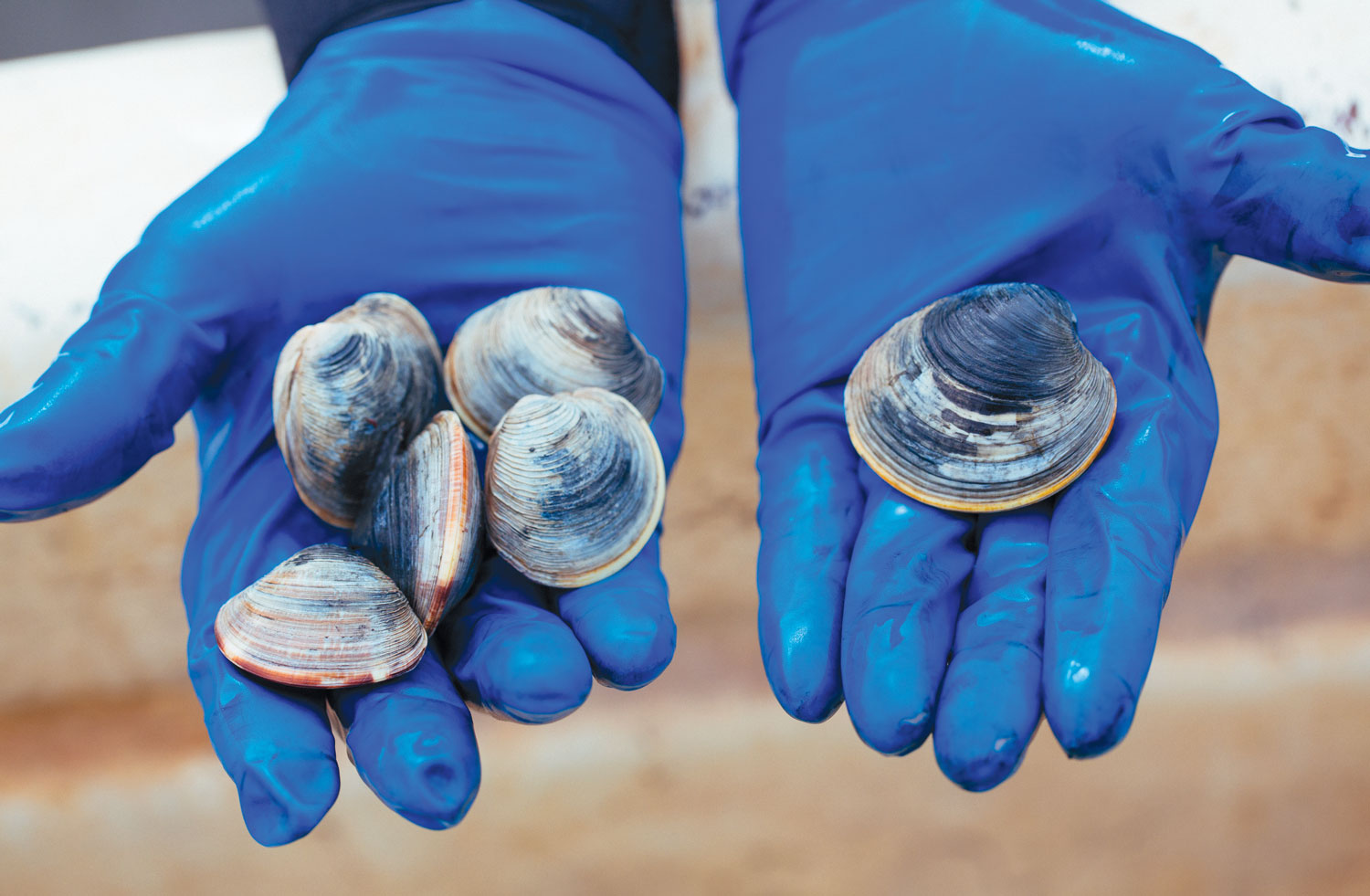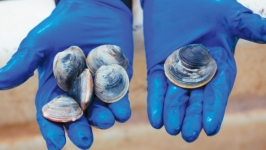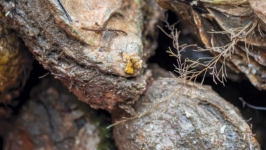Writing the Clam's Next Chapter
Aquaculture is the wave of the future for NJ’s iconic bivalve
“Mother Nature, she’s the boss.” Billy Mayer looks at the bay, his eyes taking on the deep blue hue of the waters where Obes Thorofare and Steelmans Bay meet. “You have to look at the moons. You have to look at the tides. All that knowledge? Nobody is going to teach you that. You can’t describe that. It’s just something that you pick up over time.”
Mayer speaks to a primal truth with the poetry of a man who has spent decades on the water. “That [knowledge] has been around since the Native Americans. That has been around since First People: the moon and the stars, the skies and the wind.” You can plan all you want, but bay life relies on being in lockstep with nature’s changeable heartbeat.
Here’s the thing: Mayer is just 23—though to be fair, he and his sister Nicole have been on the water nearly that long. “I’ve been doing this since I was three years old,” he says, referring to days spent treading for clams with dad, Bill, testing pH levels in mom, Lori’s, algae lab at the hatchery and chatting up customers at farmers’ markets as his sister cooks up Facebook posts.
“Before I was in high school, I was selling clams. This is my life.” Son of a firefighter-turned-full- time-clammer and a marine biologist, Mayer views his work as a heritage. Still, he’s a rarity in an industry where gray hair is the unifying fashion statement. As in dirt farming, clam farmers are getting on in years. Mayer knows one clam farmer under 40, and that guy is mostly in scallops.
“Every new person who wants to get out of the office job is turning into an oyster farmer,” he says. “Nobody’s jumping into the clam industry.” There’s a reason. It takes two-to-four years to grow a littleneck, so you’re sitting on your investment. Oysters can hit the market in 18 months. Mayer, who returned to the family business after graduating from the University of Delaware, sees his status as one of the only young farmers as an advantage. Demand will rise. Supply will dwindle. “I’m getting a jumpstart,” he says. (Can you tell he was an economics major?)
Over the winter, the Mayers, who operate Clam Daddy’s out of Brigantine, expanded their second nursery location in Atlantic City, adding 33% capacity at a time when some view the industry as threatened. In some bays, wild clams have been disappearing. Then there’s market pressure from neighboring states like Virginia, which send millions of clams into our local market. According to the 2015 Virginia Shellfish Aquaculture Situation and Outlook Report, the state is #1 in hard clam production in the country. (See Sidebar: A Tale of Two States.)
Still, Mayer sees nothing but potential. “I’m lucky enough to be working with my family,” he says. “The love and passion you have for it—it’s an indescribable kind of thing.” As he talks, he cleans silt from a row of buckets set in whirring upwellers, ensuring that the hundreds of thousands of baby clams inside—some so small they look like sand—enjoy optimal growing conditions. This year, the Mayers went from one to three spawns, and will plant millions of clams. “The oceans can’t keep up to us,” Mayer says. “Aquaculture is the wave of the future.”
As it happens, the parcel where he works sits next door to the property where the entire East Coast clamming industry was transformed nearly a half century earlier.
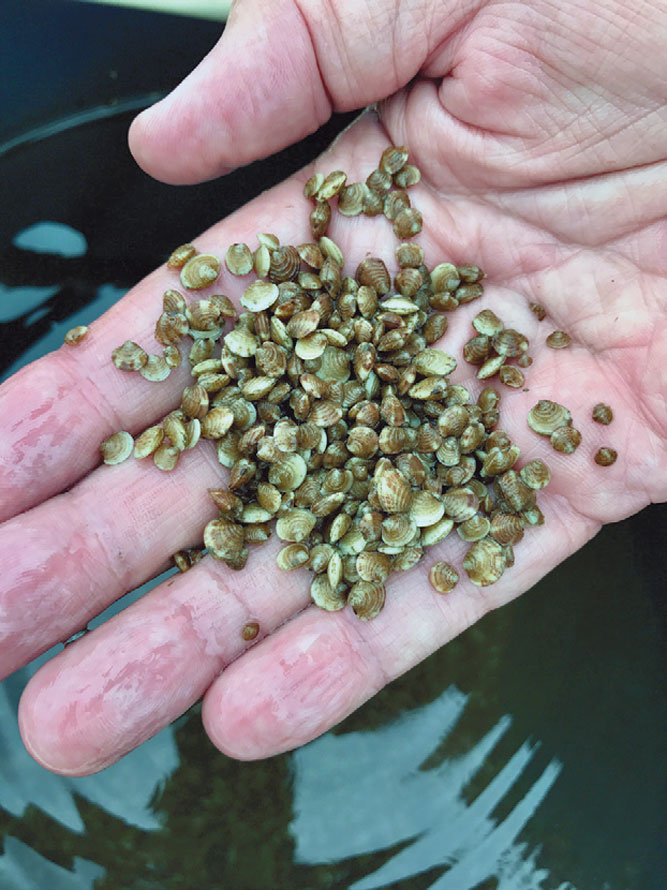
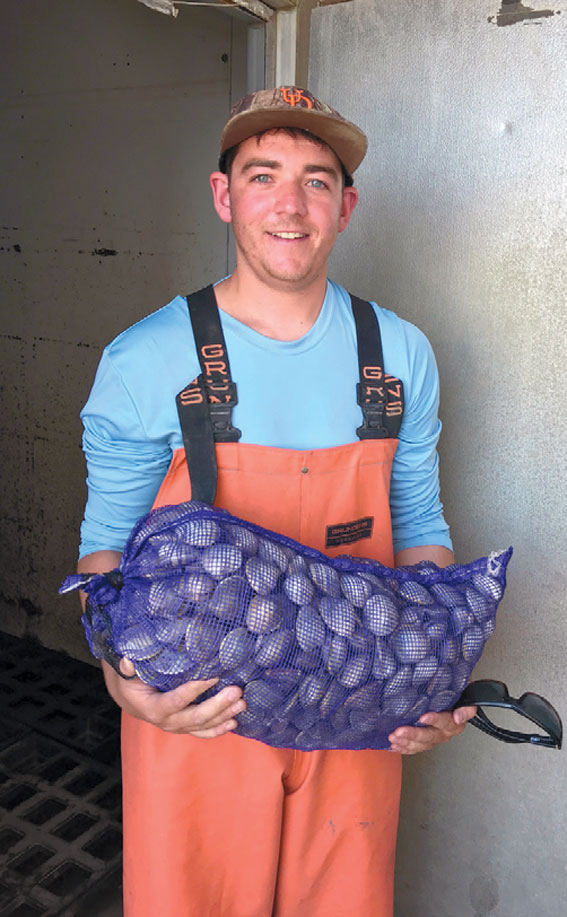
PHOTOGRAPH: JENN HALL
“Not every clam’s a clam. Our clam grown here, and our clam grown across the bay? I can tell the difference. I can tell.” —Billy Mayer
From the Wilds to the Farm
To get to Richard (Rit) Crema’s place north of Smithville, you take a dirt road to a dirt road that winds down a pine-lined drive. No one’s finding this place unless he knows about it, which suits Crema fine. Barring a handful of years spent in the Navy in the 1950s, he’s been living here with his wife, Barbara, since they married 62 years back— and yes, he built the house himself.
Baymen are not in the habit of boasting, especially with outsiders. A spry 84, Crema is modest about his accomplishments. They’re significant. He and a small group of clammers were the first to launch a commercial hard clam hatchery on the Eastern Seaboard. In time, it would alter the course of clamming here.
They had little choice. During the late 1960s and early ’70s, wild stocks in South Jersey were in decline—a disaster largely manmade. That story could fill a book. Here it is in a nutshell.
Around mid-century, the Campbell’s Soup Company of Camden started to use surf clams instead of hefty, chowder-size bay clams for their soup. This came on the heels of experiments of their own with hard clam farming in Hammock Cove off of Galloway, more commonly referred to as Dry Bay.
“They were growing tomatoes, potatoes, and everything else for their soups. Why couldn’t they grow clams?” says recently retired marine extension agent and professor emeritus Gef Flimlin, who dedicated much of his 38-year career with Rutgers Agricultural Extension to the industry. “It all fell apart when they discovered the surf clam. Now, Campbell’s Soup had plenty of clams to deal with. They didn’t have to raise them.” Ocean stocks were massive, and surf clams could be dredged in great quantities.
This dried up a major outlet for baymen, some of whom delivered chowders to Campbell’s by the train-car load. The baymen turned to littlenecks. Yet, as harvests of these smaller clams increased, seed stock remained limited.
At the same time, coastal development was in full swing. Clams are hearty yet sensitive, attuned to shifts in tidal flow and salinity. You impede the natural movement of inlets by building neighborhoods? Then add a nutrient overflow via the fertilizers that feed those neighborhoods’ green lawns? Estuaries in South Jersey changed, Flimlin explains, becoming less hospitable to shellfish. In part, this was tied to eutrophication, a process through which excess nutrients promote an uptick in plant life that consumes oxygen and suffocates their bivalve neighbors.
Crema watched populations fall. “Everybody that was doing it was depending on the wild clams for their livelihood, and you didn’t have to be too smart to know that wasn’t going to last too long,” he says. That got him to wondering. What if he could raise clams from seed?
Around 1970, he and his peers started gathering seed clams from the Goosebar, a productive square mile of shallow, sandy water on the southern reach of Little Egg Harbor Bay. It was a good idea with a drawback. “Until we learned how to protect them from the crabs, it was just totally useless to plant,” Crema remembers. The crabs saw the clams thrown on their leases, mostly used as holding grounds for wild clams in those days, as a buffet.
Then Crema’s friend Don Feldeisen found an article. At the Virginia Institute of Marine Sciences (VIMS), researchers John Kraeuter (later with Rutgers) and Ray Castagna were raising hard clam seed in a hatchery and experimenting with new field planting techniques, picking up on a history dating to the 1920s. Crema called and introduced himself. Joined by their wives, Barbara and Jean, Crema and Feldeisen went down to investigate.
“We knew nothing except going out in the bay and harvesting wild clams at that point,” Crema recalls. “There was no thought when I first started clamming, no thought of anything except harvesting wild clams.” But Castagna and Kraeuter saw something in the pair. “He said, ‘You two guys have the best chance of doing anything with this of anybody I’ve talked to yet.’ I don’t know what we said that made him decide that,” Crema laughs. “But he stuck with that statement for a couple of years.”
What Crema had done was activate a new way to raise clams in scale.
In 1974, he and Feldeisen partnered with Rich Beckley, another VIMS trainee, to open the first hard clam hatchery on the East Coast. They sold their first farm-raised clam in ’76. While wild clamming continued—particularly in northern Monmouth County, where a depuration program allows for clamming in restricted waters—the hatchery changed the game. Crema and his peers had found their method of growing clams.
“A lot of experimental type people were raising a few clams, but they couldn’t raise millions the way they were doing it,” Crema says. Asked about early obstacles, he’s direct. “Death of clams! You can kill it so easy, just like that. Yet another way of looking at the same clam: They’re tough.” Their experiences offered a commercial testing ground for new aquaculture methods. In fact, it was Crema’s idea to use the plastic mesh now standard on predator control screens.
Aquaculture took off in South Jersey, and today, there are five or six hard clam hatcheries, mostly in Atlantic County. “The baymen turned from wild harvesters to farmers,” Flimlin says. The fruits of that transformation can be traced across a family tree of baymen, including Crema and Beckley’s sons, Rickey and Ray.
Then there’s John Schriever, owner of BayFarm Inc., a hatchery and nursery, who visited Crema early on, curious. “We always vacationed on LBI, and I would clam with a bunch of kids there. You could make some money, and it was fun. I said, ‘Hey. I want to do this,’” says Schriever. “A hatchery is like working in the kitchen and a laboratory at the same time.” As for the nursery? “It’s livestock. You learn to take the best care of it you can.”
Crema retired two years ago, leaving the rest of the story to new generations. He’s convinced that his son Ray is a better clammer than he ever was.
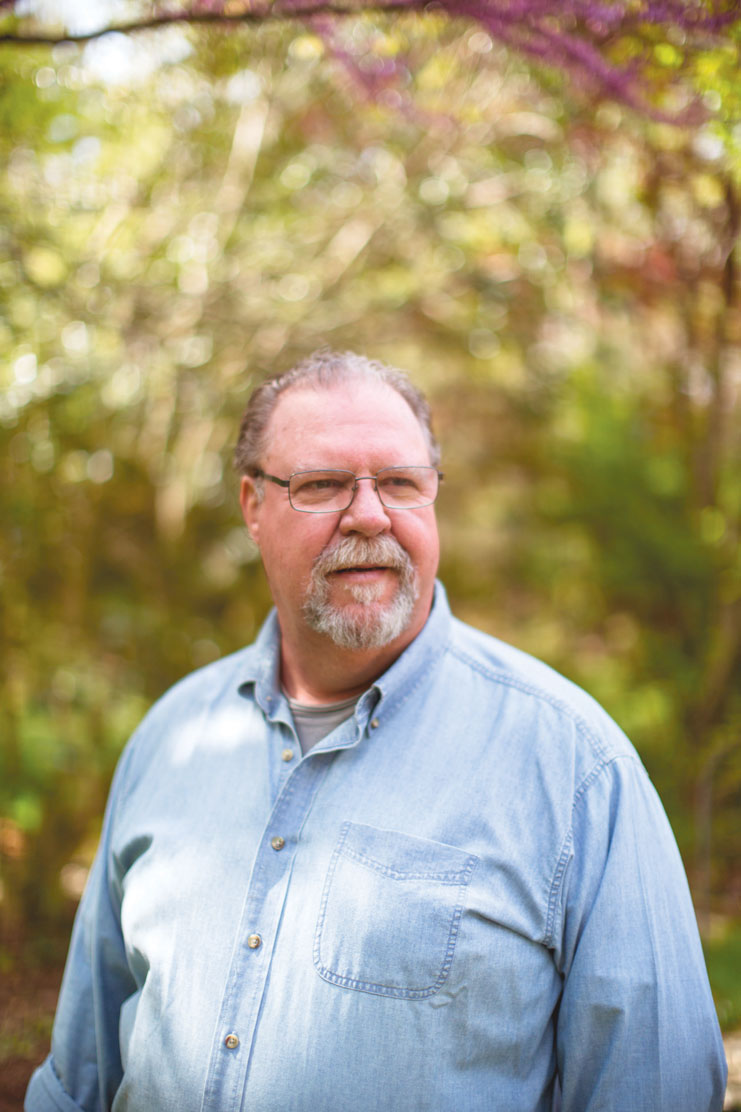
“My dad used to take me to the boardwalk at Seaside, and we’d go and eat clams on the half shell. My grandmother used to make a big tomato sauce and throw clams into it. The Clam Broth House was a place where fathers would take their sons for their first beer and some steamers or clams on the half shell. It’s about family and tradition.” —Gef Flimlin
Jersey on the Half Shell
In high season, Billy Mayer works 12- to 14-hour days, sometimes longer. As he watches his raceway network grow skyward, capable of holding millions of clams in the last grow-out stage before planting (See sidebar: Hard Clam Aquaculture 101), he’s both grounded in history and invested in the future. “It’s one of the freshest, best and locally sourced seafoods that you can possibly find,” he reflects. Across the fence, Rit Crema’s old hatchery site sits vacant, the faint lines that once marked his raceways still visible on a sinking concrete foundation. (Tempo, the Rhodesian Ridgeback hound they used for security, is also long gone.) Though Ray Crema maintains a hatchery nearby, the juxtaposition between the properties evokes the victories and challenges the industry faces. The local effort can be easily thwarted by market competition, clams shipped in from other areas.
Flimlin calls that the gorilla in the china shop. Because Virginia has a vast growing area as compared to New Jersey, it can undercut the state on price and quantity, and that makes it harder for our local clammers to make a living. They work their leases, watching the oyster market soar as littleneck prices stagnate near 1970s levels, 18–20 cents wholesale. They’re out in ice and on 90-degree days, waiting for the farm-to-table ethos to reach the bay. “Ask people. Are they from Virginia? Are they from Florida? Are they New Jersey clams? Everybody does that about oysters, but no one asks about clams,” Mayer says.
They should. Our clams are tender and sweet, kissed with salt and succulent whether cooked or raw.
Flimlin technically retired at the end of 2016. He could be relaxing at his dream home in Maine. Instead, he continues to consult with the clammers he’s supported for decades, driving back and forth between states. “We got so close to them, and our lives revolved around helping them,” he says. “I saw how they worked. I saw how they interacted with the water. Their connection to place.”
The way he sees it, hometown clams need a brand—something that conveys the rich history of our baymen, but also of families for whom local shellfish was a summertime ritual. “When I was a kid, my dad used to take me to the boardwalk at Seaside, and we’d go and eat clams on the half shell. My grandmother used to make a big tomato sauce and throw clams into it,” he says. “The Clam Broth House was a place where fathers would take their sons for their first beer and some steamers or clams on the half shell. They’d throw the clam shells on the floor, which was covered in sawdust. It’s about family and tradition.”
Flimlin is a big believer in co-ops, which he first promoted in the ’90s. Working with George Mathis, he played a key advisory role in launching Heritage Shellfish Cooperative (see page 51). He also thinks clams can benefit from retail packaging that gives them a name and makes them easier to identify. It’s why Heritage Shellfish Cooperative brands their clams Eventide Littlenecks—named for the slack tide, when everything stills as the tide changes. “We need a new way to get a really good product into the hands of convinced consumers, people who understand what good product is,” he says. “Every oyster has got a name on it.”
Flimlin would also like to see the state launch a hard clam aquaculture apprenticeship program, perhaps hosted by his former employer. “Clams are three things: They’re food, they’re jobs and they’re money,” he says. “Take somebody under your wing. Get them a lease, even if you put up some money for them for screens and clams that they have to take care of.” Young aquaculturists could learn the ropes, perhaps as a second job, without facing the full risks that come with a three-year investment.
A Clam’s a Clam’s a Clam?
Supporting our baymen seems like a no-brainer, and the reasons to enjoy local steamers go beyond the plate. Just like oysters, clams are filter feeders, having a net positive effect on the ecosystem. They’re farmed in natural bay water, chemical-free. Add in strict water quality regulations, and it’s one of the cleanest foods you can eat, available year-round.
Yet, “a clam’s a clam’s a clam” remains a common refrain on the water and off—and it will be until consumers reconnect with New Jersey’s coastal foodways, perhaps even paying a premium for local product. If your imagination is stoked when you see a lone clammer in a skiff against a blazing sunrise, seek out Jersey clams. If you just like a tasty bivalve, immune to romantic imagery, seek out Jersey clams.
“New Jersey is known as the Garden State, but nobody even knows about the gardens on the water,” Mayer says. “Not every clam’s a clam. Our clam grown here, and our clam grown across the bay? I can tell the difference. I can tell.”
As Flimlin says, “the clammers carry the story.”


